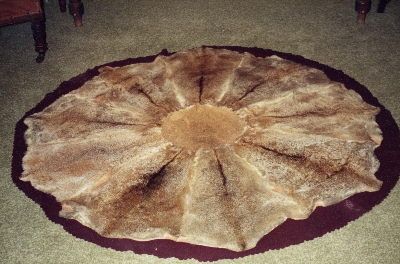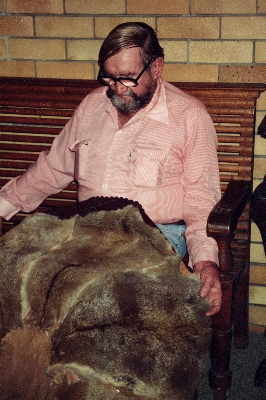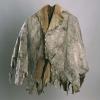Quilt No.120BF - Bud and Patricia Ford

Owner:
Bud and Patricia Ford
Location:
QLD South West
Maker
Maker:
Unknown
Made in
AUSTRALIA QLD
Patterms
Date:
1921 - 1940
Description:
Round rug of whip tail wallaby skins pieced into centre circle. Skins have been joined and then stitched on to maroon baize backing which has traditional punched scalloped edge. The skins are wattle bark tanned.
Diameter 1449mm
History:
The wallabies were snared (not shot) by a Mr. Kynock's son in the scrub near Ravensborne Queensland. They were wattle bark tanned at the Cloake Tannery in Toowoomba. The rug was constructed by Hugh Bird Ford, father of the present owner, in the 1930s. The rug is not used now but is in the music room of Bud and Patricia Ford's home over the back of a chair.
Story:
Mr. Kynock's son who snared the whip tail wallabies was paid 2/6 each for them. After they were wattle bark tanned at Cloake's tannery in Toowoomba, Hugh Bird Ford [1895-1968] used a template of 3 ply to get them all the same size.
Bud Ford, present owner and son of the maker, recalled that the rug was always on his parents large double bed and that his father was very proud of it.

Bud Ford with the whip tail wallaby rug
Related Quilts:
Kangaroo skin cloak of seven gores is made from the skins of seven grey kangaroos (Macropus fuliginosus). The skins vary in size and shape, the inner five are roughly triangular. The cloak is edged with a series of loops, through one of these near the collar is a piece of cloth which appears to have tied the cloak together. The skins are sewn together with two sorts of linen or cotton thread. In a small diamond-shaped gusset at the back of the neck there are some stitches of sinew. The skins are sewn together by means of a small hem which was turned back on to the fur, so stitches went through two layers of skin on each gore. There are some small holes in the skins. The skins are very soft and pliable, and greyish in colour; they vary in size and shape.
Longest part: 800mm
Ref: MA Thesis 1973, S.Meagher 'A Reconstruction of the Traditional Life of the Aborigines of the S.W. of Western Australia.
Wallaby skin rug backed with checked cotton material.
1220 x 610mm
Rug made from 40 quoll skins, 8 skins set in 5 rows. Skins are trimmed to rectangles and machine stitched together. Colours range from light cream to grey-brown with creamy yellow spots. The backing is dark green woven wool which extends beyond the top and is finished with a scalloped, punched edge. It is hand sewn to the top.
1575 x 1255mm
Animal skin rug made from rough rectangles of kangaroo skins, hand sewn together with leather thonging. Backing is woollen blankets.
2135 x 2057mm
Fox skin rug made from 28 winter fox skins, with turquoise green felt backing and with green felt scalloped edging. Part of some tails as edging remain. Skins hand pieced together, top sewn to backing by machine.
1550 x 1550mm
Round rug of whip tail wallaby skins pieced into centre circle. Skins have been joined and then stitched on to maroon baize backing which has traditional punched scalloped edge. The skins are wattle bark tanned.
Diameter 1449mm






